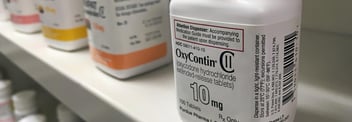Americans In Pain and Addicted: Untangling the Opioid Crisis
- Home
- Blog

Part Eight (Finale): Pain, Pain, Go Away! Final Insights from Experts
Do you remember the story of Sally? She was my dear friend I mentioned in the very first post I wrote for my opioid series. A warm woman with a successful career, three kids, and a loving husband, from the outside it seemed that Sally had it all. Her stable, secure lifestyle seemed the opposite from the stereotypical life of an addict. And yet, Sally became addicted to one of the strongest, most dangerous prescription drugs on the market today. Sally’s life was turned upside down by one little pill, derived from a beautiful red flower that grows on rolling rural hillsides. Sally was addicted to opioids.
For the last eight weeks, we’ve set about untangling the opioid crisis thread by thread—beginning with its origins, which reach far back into the history books of China and Great Britain, among other powers; moving into the nature of addiction itself; reflecting on two very different stories of women who hit their rock bottom—yet climbed back toward the light; providing insight into the invisible sufferers; and finally handing the mic to you, the readers, whose own personal experiences with this epidemic have been in parts emotionally painful, illuminating, and inspirational. As one reader commented, in regards to addicts on the street, “We take care of each other out here.” This is as powerful a statement as any I could ever make about this crisis. Because it comes down to the power of connection: The only way out is through connecting with each other, with ourselves, and with the knowledge and insights that a team of experts can guide us towards to help us heal.
When you search the words “Opioid Crisis” on the internet, mountains of alarming articles pop up, but precious few provide well-researched background on the origins and ever-evolving dangers of the epidemic. The dearth of information is what prompted this series in the first place. I truly believe that without that connection to knowledge and resources, people will continue to be harmed—not just from the drugs themselves, but from the social stigma surrounding this sensitive issue, and from the latent fear that many of us continue to hold arising from a lack of understanding about the drugs.
Blame, shame, fear, and confusion don’t serve us, dear reader. These emotions slowly eat away at our best and most human attributes of love, empathy, and compassion. I’m so thankful that you’ve followed along with us on this journey toward understanding. And with that, I leave you with a final resource guide—comments from psychiatrists and other pain experts who have worked with addicted patients for years, and provide their insights as to how someone with chronic pain can safely recover. Read their words, reflect upon them, and then—let’s keep the conversation going. I encourage you to reach out on my social media channels to join with others like you who have something to say, a question to ask, an insight to mull over with others. Connection is everything. We can all help one another become whole.
Final Insights from Experts, to Begin to Heal
The preferred path to ease emotional pain isn’t just psychological—it’s physical, too
For this post, I’ve gathered the opinions of experts—and I’d like to begin with my own insights. Physical pain and emotional pain are intimately connected. Physical pain worsens emotional pain and frequently causes symptoms of depression and anxiety. In one study, 60% of patients with chronic pain developed depression, with 33% of those patients suffering from severe depression. Patients in pain who also suffered from depression reported greater work absence, greater pain-related interference with daily functioning, and more generalized pain. Other studies of chronic pain patients report that anxiety disorders were also present in 59% of men and 66% of women. What can we do to ease their emotional pain, which in turn will lessen their physical pain? Let’s use the biopsychosocial model to understand and treat them. There is a significant role for SNRI antidepressants. Lifestyle interventions that reduce inflammation can also be helpful, including better nutrition, improving gut health (your microbiome), and even certain supplements. These treatment approaches may also be combined with cognitive behavioral therapy (CBT), which can further ease emotional and physical pain. These healing methods (and more) can be found in my Four Steps to Feel Better Today.
Pain meds aren’t always the only treatment: Advocate for non-pharmacologic interventions first
“From 1990 to 2015, neck and low back pain have been the number-one cause of disability worldwide. Only this past year has depression taken over as the leading cause. Science has also shown that chronic pain leads to depression. I think it’s safe to say that the standard medical model of treating spine-related disorders (SRD’s) has not worked. What does scientific evidence now say is effective for treating these conditions? Multiple clinical practice guidelines, the highest level of scientific evidence, support non-pharmacologic interventions first! Treatments such as exercise, spinal manipulation, acupuncture, yoga, cognitive behavioral therapy, and massage are evidence-based interventions that actually get to the root cause of the problem and ultimately solves the issue. Neck and low back pain are complex, multi-variate conditions. Inflammation and abnormal movement patters that occur due to everything from postural issues to acute and chronic injuries, are the precursor and underlying cause of painful SRD’s. Thus, at the end of the day, it’s both a neurologic and biomechanical issue. Utilizing treatments to reduce pain, optimize joint mechanics to allow for full range of motion, and neurologically correct movement and muscular control through appropriate rehabilitation exercises, have dramatic positive impact on patient outcomes.”
—Dr. Jay Greenstein, CEO, Sport and Spine Companies
Because of the way opioids can change our brains, for some patients medication is the only solution to break free of addiction
“The word ‘addiction’ is not one size fits all, and treatment therefore varies depending on the individual, their circumstances, and the substance they have been abusing. One of the primary goals of any addiction treatment is the prevention of recidivism or relapse. You want your patient to be able to walk away from their disease as close to whole as possible. Opioids have an extremely high rate of relapse—nearly 80%, in fact. This is due in part to the fact that this particular type of drug fundamentally alters the user’s brain–specifically, their opiate receptors, which control our feelings of pleasure and pain. Our bodies naturally produce endogenous (internal) opioids called endorphins, but prolonged use of opioid drugs can permanently damage our ability to do so. This can make addiction treatment particularly difficult, because without those naturally occurring chemicals, we feel pain more fully and experience pleasure less and less. This may sound like a dire picture, and frankly, it is. While there is no debating their effectiveness in pain treatment, opioids are incredibly serious drugs that should be prescribed and taken with caution. However, I’ve found that suboxone can greatly help opioid addicts who are serious about taking their lives back. Suboxone combines two medications: buprenorphine and naloxone. Buprenorphine, which is what’s known as a “partial opioid agonist” or an opioid that produces less of an effect than a full opioid, prevents craving and withdrawal symptoms in the brain without producing that euphoric high that addicted patients seek to return to. This partial agonist also acts as a blocker against full opioids, which means that when taking suboxone, patients can no longer get high, even if they wanted to. Naloxone, the second part of the drug, acts much in the same way—by blocking users from feeling any effect from opioids, should they take them.
If this seems complicated, it’s because it is. I’ve had some patients on suboxone for weeks, and others on it for years. Because the brain can be permanently altered after years of abuse, this drug acts as a mitigating force. I wish I could tell you that folks can easily come off suboxone and be healed. But for serious addicts, that’s often not the case, which is why they need this medication for years, and not just for the purposes of tapering.”
—Dr. John Carr, Clinical Psychiatrist and Suboxone Certified Doctor
Sometimes, a dedicated team makes all the difference
“Pain is one of the oldest yet most complex clinical problems. These blog posts have discussed how chronic pain and addiction can significantly decrease quality of life and leave good people feeling hopeless. While there is no universal quick-fix solution, I think the blogs also highlighted that it often takes a team to combat these problems. From the patient, to family and friends, to specialist physicians, to even internet strangers who can empathize with your story, having a dedicated and passionate team can solve even the most overwhelming problem. As pain management specialist, we are experts at diagnosing pain generators and offer the best evidence-based medicine. Our field is constantly developing new technology and medications with exciting potential, but we are still limited because pain is just so darn complex. With my own patients, I tell them that I have joined their team and will offer my perspective and ability in their fight for the best quality of life possible.”
—Dr. Sloane Yu, Interventional Pain Medicine Fellow, Dartmouth-Hitchcock
.png?width=144&height=144&name=Untitled%20design%20(34).png)



